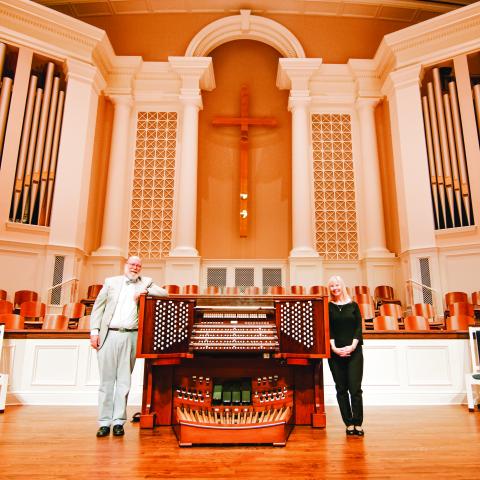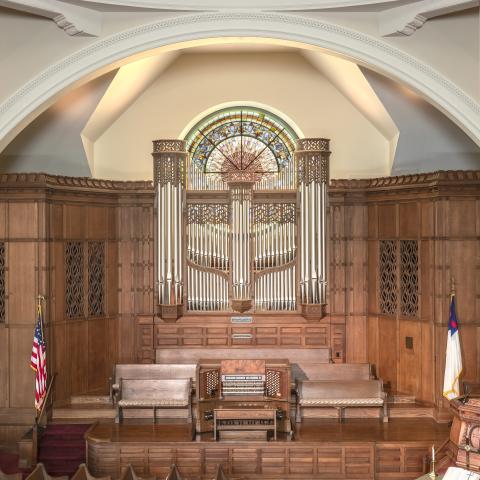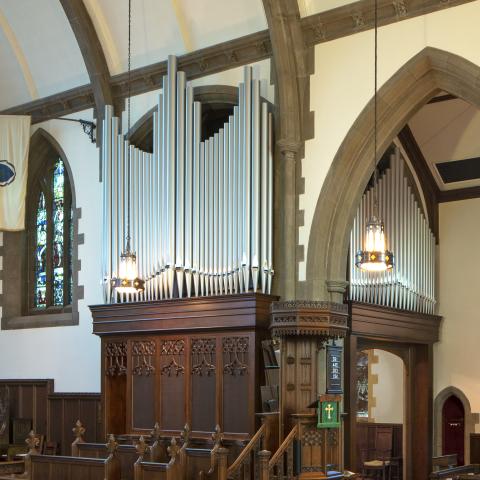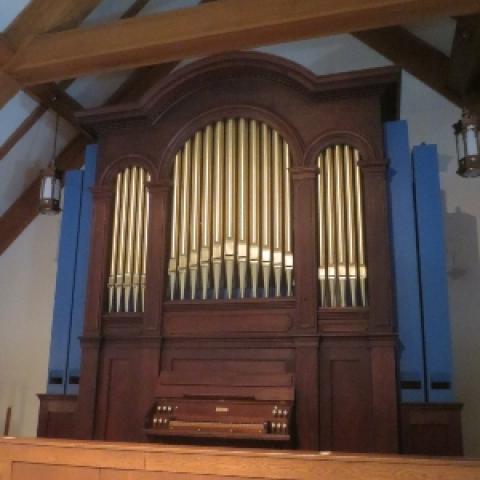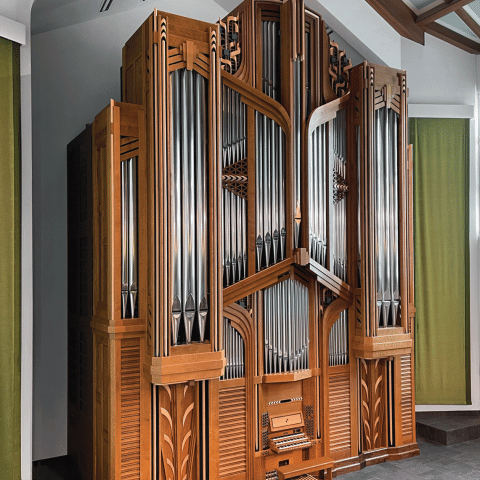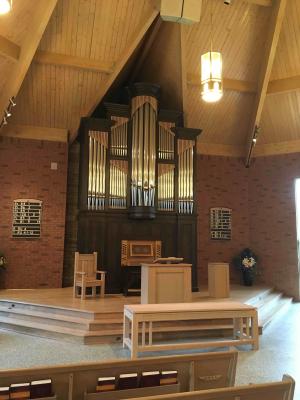
David E. Wallace & Co., Pipe Organ Builders, LLC, Gorham, Maine
Canadian Reformed Church, Ancaster, Ontario, Canada
Early in 2011, members of the Canadian Reformed Church in Ancaster, Ontario, contacted David E. Wallace & Co. Pipe Organ Builders about providing an instrument ideally suited for their worship space. When the building was constructed the plan had been to acquire a pipe organ at some point in the future.
The “future” finally arrived when their temporary instrument had suffered one catastrophic malfunction after another. The church body decided the time had come for a permanent solution and determined that their musical needs could be best served by having a fully mechanical organ designed to fit on a relatively small footprint at the front of the room. After several years of discussion, planning, and development, the church signed a contract with David E. Wallace & Company early in 2016, and construction began a few months later.
Visually, structurally, and mechanically our Opus 78 draws inspiration from organs built in New England from the early- to mid-nineteenth century. We designed the new case to support the interior components of the organ as a single cohesive unit that renders the instrument as pleasing to view on the inside as on the outside. We constructed all interior and exterior elements in the classic manner, with traditional mortise-and-tenon and dovetailed joinery. The design of the wind system is historically inspired as well, with a main reservoir patterned after an 1893 George Hutchings example feeding wind through traditional wooden wind trunks. The key action design is centered on simplicity and uses techniques that have stood the test of time to provide the organ with a light and articulate touch.
At ten stops, the Great offers dynamics that range from colorful flutes that have their foundation in a 16′ Bourdon to a powerful principal chorus. The Great chorus is topped by a IV Cornet that can either stand out as a solo voice or blend well with the Great chorus.
The foundation of the Swell chorus is a generous scale 8′ Violin Diapason that gives the Swell division its own source of power and color while maintaining its ability to complement or contrast the Great. The Swell division also includes a Diapason Celeste, a stop that offers a robust sounding celeste with the swell box open and a subtle and warm celeste tone with the box closed.
The two unified ranks of the Pedal division stand on mechanical slider chests. Unification of these stops by means of a second pallet and channel divider assures that pipes speak consistently whether played from the 16′ or 8′ stop. The Pedal 16′ Double Open Diapason was scaled to provide a strong but articulate diapason sound, suitable to underpin both full organ and lighter registrations. The Pedal division delivers a combination of gravity and clarity necessary to support a church filled with inspired singers.
Installation of the organ was completed in August 2018, and the instrument was presented to an enthusiastic public during an open house at that time. We share the pleasure of the congregation in anticipating that this new organ will provide solid, enduring musical support for their worship services, and has already started to serve as an inviting base for long-term musical outreach to area organists, teachers, and music programs.
The project team for Opus 78 included Nick Wallace, Seth Doyle, Jake Hanin, Rebecca Schnell, Joe Lendway, Marissa Hall, Nicole Pelonzi, Alex Stewart, Blair Batty, Derek Verveer, and David Wallace. Additional information and photographs of this project appear on our Facebook page.
The Ancaster organ is our first installation of an instrument in Canada. We have previously placed an organ in Belgium, 1854 E. & G. G. Hook Opus 173, and relocated a large, modern two-manual tracker organ from Germany to a client church in New Jersey. International placement of our instruments continues to offer a unique and enjoyable set of challenges for our shop.
GREAT (Manual I, 58 notes)
16′ Bourdon
8′ Open Diapason
8′ Viola da Gamba
8′ Melodia
4′ Octave
4′ Flute d’Amour
2′ Fifteenth
2′ Mixture III
4′ Cornet IV
8′ Trumpet
SWELL (Manual II, 58 notes, enclosed)
8′ Violin Diapason
8′ Diapason Celeste (TC)
8′ Stopped Diapason
4′ Principal
4′ Flute Harmonique
2-2⁄3′ Nazard
2′ Flageolet
1-3⁄5′ Tierce
8′ Oboe
Tremulant
PEDAL (30 notes)
16′ Double Open Diapason
16′ Bourdon (Gt)
8′ Clarabella (ext 16′)
4′ Choral Bass
16′ Trombone
8′ Trumpet (ext 16′)
Couplers
Great to Pedal
Swell to Pedal
Swell to Great
Swell expression shoe
Wind (Blower switch)
Builder’s website:
Church website: https://ancasterchurch.on.ca
2 manuals
25 stops
27 ranks
1,358 pipes


